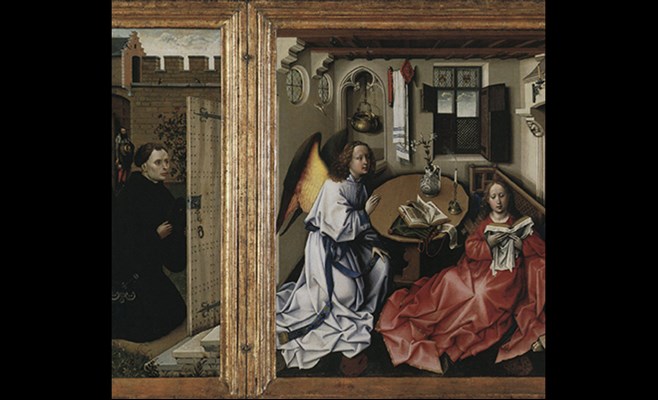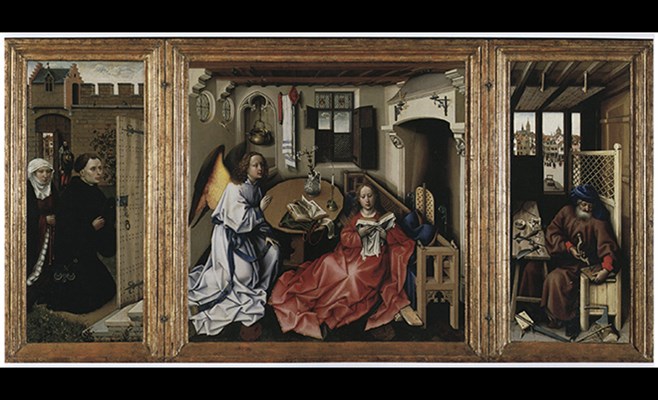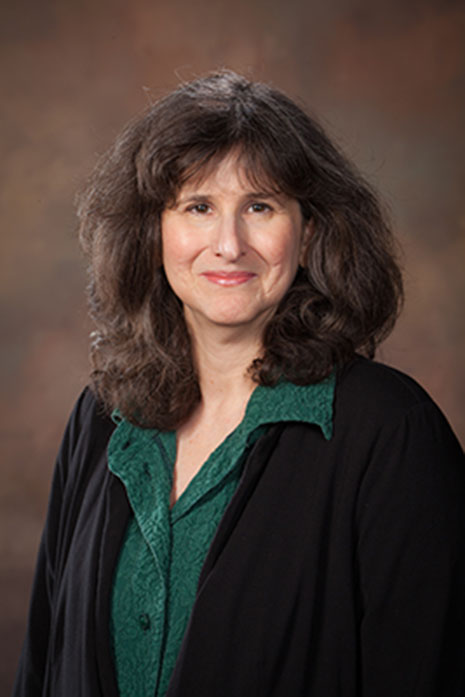Opening Minds Through 'Opening Doors'
FAYETTEVILLE, Ark. – Art historian Lynn Jacobs looks at triptychs as “paintings with doors.” Her study of triptychs produced in present-day Belgium and the Netherlands during the 15th through the 17th centuries examines the relation between artistic format and meaning.
A triptych is an artwork that is divided into three separate panels. Triptychs were commonly used in churches as altarpieces, although they also served a variety of functions, including as grave markers and devotional objects within the home.
In her book Opening Doors: The Early Netherlandish Triptych Reinterpreted, Jacobs analyzes the meanings that arise from the thresholds and boundaries of the triptych format, while focusing on the implications of divisions and interconnections within the pieces. In the triptychs Jacobs studied, panels are hinged together and can either be shut or displayed open. It is a practical format: side panels or wings protect the center of the triptych from damage.
In addition, the structure allows for changing imagery and the multiplication of panels permits greater narrative elaboration as well as the creation of different pictorial worlds. She found that the panels not only were called “doors” in the documents of the period, but also acted as doors that create thresholds between zones, often between holy and earthly spaces.
For example, in one of the best-known Netherlandish triptychs, Robert Campin’s, “Mérode Triptych,” the center panel depicts the Annunciation with Mary the virgin and the angel Gabriel. In the left panel, there are two donors — a man and a woman at an entry door — with a messenger in the distance; in the right panel, Joseph is shown in his workshop.
In this painting, the frames around the left and center panels separate the representation of an opened door on the left panel, and a barely visible doorframe shown within the center panel, to the left of the angel Gabriel. However, the door frame in the center panel is positioned too high to line up with the door in the left panel, thereby creating an ambiguous relation between the two spaces. In this way, Jacobs argues, the artist is raising questions — which are deliberately left unanswered — about the connection between the profane and sacred realms. This spatial arrangement offers the donors the promise of transcendence into the holy, while still keeping the sanctity of the virgin mother and the angel Gabriel, intact.
Jacobs’ research on early Netherlandish painted triptychs was influenced by her trip to the Prado Museum in Madrid. There, she had the opportunity to visit the museum when it was closed to the public and view the triptychs in their open and closed states, a rare and, she said, “life-changing” opportunity. This experience gave her more clarity and understanding of the triptych format and compelled her to begin a full study of this once-popular art form.
“It wasn’t until I was studying the iconography of “The Garden of Earthly Delights” by Hieronymus Bosch and wasn’t making any headway that I started to become interested in the work’s format,” Jacobs said. “One of the most important advances in my thinking came from getting a chance to go to the Prado and see three of Bosch's major triptychs — which usually are displayed only with the wings opened — both in their closed and opened states. It was then I realized that there was a lot to be said about this particular format that had not yet been said.”
Jacobs recalls an experience from the beginning of her research: “I had just had my son, and was driving with my husband and his brother to the Cloisters Museum in New York to take a quick look at the “Mérode Triptych.” I told my husband to just stay in the car with the baby and that I wouldn’t be long,” Jacobs said. “Little did I know, I started talking to my brother-in-law about what I was working on and everyone jumped in on the conversation, from the public to the museum guards. We all got into a deep conversation and then I see my husband, an hour and a half later, carrying my son and steaming mad. I had totally lost track of the time because it was so exciting to me that I wasn’t the only person who was interested in the questions raised by this triptych.”
Jacobs is a professor of art history in the J. William Fulbright College of Arts and Sciences at the University of Arkansas. Her research was funded by a fellowship from the National Endowment for the Humanities, as well as financial support from the University of Arkansas and grants from the Fulbright College. Opening Doors: The Early Netherlandish Triptych Reinterpreted is published by the Pennsylvania State University Press.
Contacts
Lynn Jacobs, professor
Department of Art
479-575-5202,
ljacobs@uark.edu
Liana Bugslag, intern
University Relations
479-575-5555,
lbugslag@gmail.com
Barbara Jaquish, science and research communications officer
University Relations
479-575-2683,
jaquish@uark.edu
Headlines
U of A Bands to Hold Three Nights of Concerts
The Symphonic Band, the Wind Symphony, the 4 O'Clock and 5 O'Clock Bands and the Wind Ensemble will perform April 21-23 at the Faulkner Performing Arts Center on the U of A campus.
Honors College to Host 'Best in Show' Dog Celebration
The campus and community are invited to celebrate our furry friends with popsicles, water and dog treats from 3-4 p.m. Thursday, April 25, in the Gearhart Courtyard.
New Parasite Affecting Canadian Partridges Named for Arkansas Poultry Scientist
A long-time colleague in Canada gave a newly found parasite the scientific name Eimeria hargisi in honor of U of A poultry science researcher Billy Hargis.
U of A School of Law Student Selected for Ms. J.D. Leadership Academy Intensive
Tristan Branstetter-Thomas, a second-year law student, was one of 30 students from across the country chosen to participate in the leadership academy at the Northwestern Pritzker School of Law in Chicago.
Needy Honored as Distinguished Alumna of University of Pittsburgh Engineering College
College of Engineering Dean Kim Needy was among seven alumni of the University of Pittsburgh Swanson School of Engineering honored in April as part of the 2024 Class of Distinguished Alumni.







